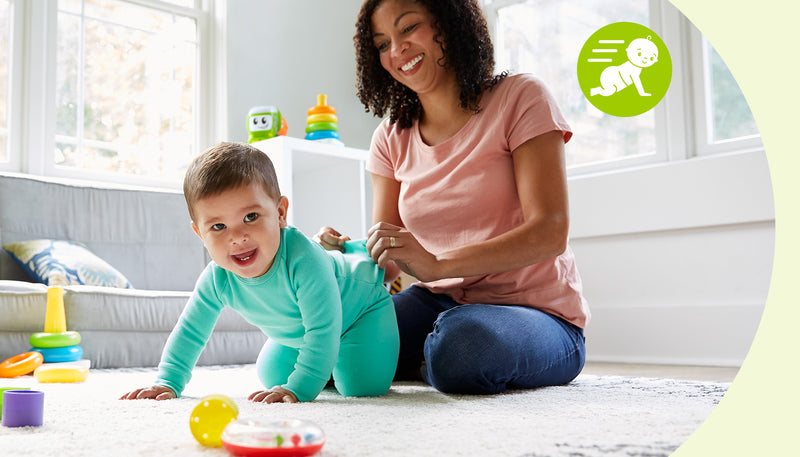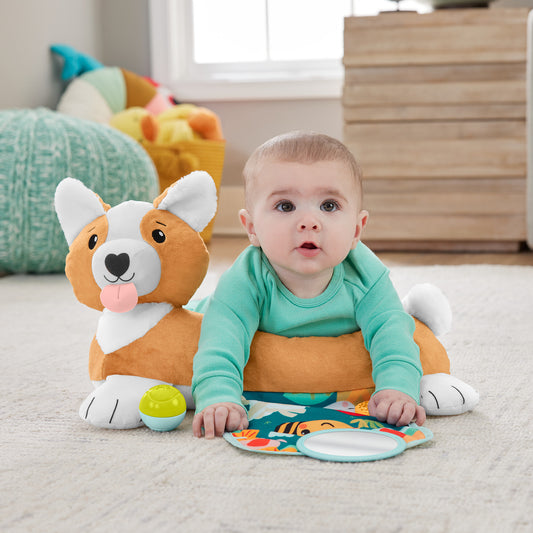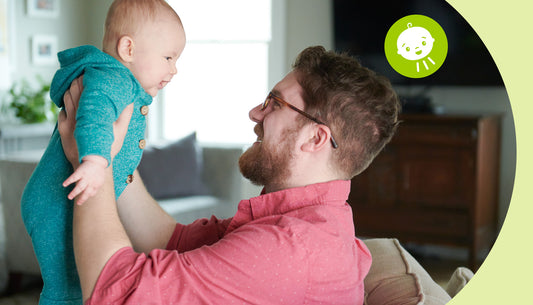
Common Crawling Questions Answered by a Childhood Development Expert
Lisa Lohiser, Ed.D.
Manager of Early Childhood Development Research at the Fisher-Price Play Lab and Mom of 2
Ed.D. Learning and Teaching in Social Contexts
M.S. Creativity & Changed Leadership
B.S. Elementary Education
Say hello to happier parenting. We’re here to help you celebrate the little victories, let go of expectations, and pick up more positivity. Because after more than 90 years of helping families, we’ve learned that development happens naturally when fun leads the way.

Curious about crawling? You’ve come to the right place.
Hi, I’m Lisa, and I’m an early childhood development expert (and mom of two). Throughout my years of working with parents, I’ve helped answer a lot the questions you’re probably asking yourself right now. From “When will my baby start crawling?” to “How can I help my baby crawl?” to “Is it weird that my baby only moves backwards?” (Spoiler: it’s totally normal).
As with any physical milestone, every baby reaches it in their own time, at their own pace. So, while I can’t give you an exact “first crawl” date, I can share a timeline for when to expect signs that they’re ready, help you recognize those signs, and give you some tips & tricks to get them started.

Get the gist
No time to read? No problem. Here are a few of the biggest things to know about crawling:
- It usually happens between 7 and 10 months, and movement could start as early as 4 months. But all babies are different.
- Watch for crawling signs like pushing up during tummy time & rocking forward when on all fours. If you haven’t done so already, this is a great time to babyproof your home.
- Most babies need a little motivation to get going, so give them something to crawl towards, whether that’s a favorite toy or their favorite person—you!

Why is crawling so important?
So many good things happen when babies start crawling. Research tells us (and years of observation has shown me) that it helps all areas of your baby’s development—physical, cognitive and social-emotional.
Coordination & balance
One of the more obvious benefits of crawling is the development of large motor skills (AKA physical skills). As your baby begins to support their own weight by balancing on all fours, their little muscles are putting in big work. Eventually, this ladders up to cruising, walking and running.
Navigation skills & spatial understanding
When your baby crawls, they start to get a sense of the world and their place in it. Your new crawler might stop at obstacles or try to go through them rather than go around them. But with practice (and a little problem-solving), they’ll quickly learn to navigate their surroundings.
Self-confidence
Figuring out how to move on your own comes with quite a sense of accomplishment! The more your baby crawls, the more it helps build their self-confidence. And once they get going, there’s no stopping them!
How to know if your baby is ready to crawl
There are some things you might notice your baby doing as they get ready to start crawling. Look for these signs:
- Doing mini pushups during tummy time
- Lifting or propping themselves up using their arms
- Lifting themselves up on both arms & knees
- Rocking forward & back when on all fours

How to help get your baby crawling: the basics
Beyond tummy time (which helps your baby build the core strength they need to crawl), there are some tips you can try to help start them off on the right foot—or arm and leg, in this case.

Give them a “springboard.”
Place your arm on the floor behind your baby’s feet to give them something to push against. You can also lightly push their feet forward to help them get started.

Put one of their favorite toys juuust out of reach.
For example, place Rock-a-Stack® rings at different distances like targets to give your baby something to crawl toward!

Be their crawling buddy.
Everything is more fun with a friend, right? So, show your almost-crawler how it’s done—get down on all fours and crawl along with them!
Surprising crawling tips
It’s always a good idea to have some tricks up your parenting sleeve.

Prop ‘em & rock ‘em
Position your baby on their hands and knees and gently rock them forward & back.

Help them “get a grip”
Remove their pants and socks so their legs & feet can get a little more friction.

Try different floor surfaces
If the rug isn’t cutting it, try putting your baby on a hard surface.

Crawling timeline
Most babies typically begin to crawl between 7 and 10 months old. But remember, physical milestones are not set in stone because every baby is different.
4 to 7 months
- pushes up on hands during tummy time
- chest off the ground
- crawls/pushes backwards
- rolls side to side or in a circular pattern
8 to 12 months
- gets up on hands and knees
- rocks back and forth on hands and knees
- crawls/pulls forward on stomach (commando crawl)
- crawls on hands and knees
- crawls on hands and feed (bear crawl)

Crawling styles
Babies don’t just start crawling at different times, they also tend to do it their own unique ways. So, don’t stress if your little one breaks out one of the non-classic styles (or invents their own). There’s no wrong way to crawl!
The Roller
Often a precursor to crawling, they use their entire body to roll from one place to the next.
The Bottom Scoot
While not technically “crawling”, many babies will sit upright & use their arms to scoot around.
The Classic
Up on hands and knees, moving one arm and the opposite knee forward at the same time.
The Bear
“Walks” on hands and feet, keeping their elbows and knees straight.
The Belly (or Commando)
Their body is mainly flat as they slither around on their belly while moving forward.
The Crab
Pushing up with their arms, they move either backward or sideways.

Parent check-in
So, how are you feeling about crawling? Excited? Nervous? Maybe even a little sad (because it means they’re getting bigger)? All totally valid feelings.
Crawling is a big move for your baby—and it can be a pretty moving experience for you, too. Up until now, your baby has needed you to go, well, anywhere. And soon, they’ll have their own way to get around. It is quite literally their first move towards independence.
But just know that whether they’re crawling, walking, or heading off to school, they’ll still need (and want) you there to guide them—and cheer them on.






